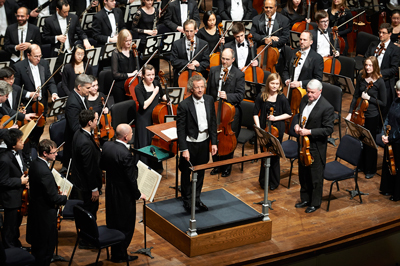by Daniel Hathaway

Beethoven’s “Pastoral” Symphony is an outlier among The Nine. Programmatic where the others are musically abstract, the sixth symphony closely follows its narrative of a day’s ramble in the Austrian countryside, complete with a thunderstorm and rejoicing peasants — once the Donner und Blitzen have passed over.
Welser-Möst took a breezy, spacious approach to the opening movement (“Awakening of cheerful feelings upon arriving in the country”), setting a brisk tempo that would pervade the rest of the symphony. Exuberant surges and transparent textures let Beethoven’s music breathe in the invigorating country air.
Beethoven’s second-movement invocation of a brook can babble on endlessly. Welser-Möst and the Orchestra let its rivulets flow gently but purposefully. The woodwind birdcalls at the end were suitably charming.
The “Jolly Gathering of Country-folk” showed off the Orchestra’s superb woodwind principals and horn section, and as the thunderstorm gathered, a bass section that has to be second to none. As the storm abated and the villagers expressed their thankful feelings, The Cleveland Orchestra’s famous blend and depth of tone came into play. The audience was so rapt throughout the symphony that nobody seemed to breathe, let alone cough.
The second half of the concert was all-Ravel and completely brilliant. His Alborada del gracioso gave principal bassoon John Clouser a divo role and let loose the Orchestra’s winds and brass in a riot of colorful effects — double tonguings, parallel chromatic runs in the flutes, sassy tauntings from the trombones.
By grafting Ravel’s La Valse onto the end of his Valses nobles et sentimentales, Welser-Möst made a compelling musical point: first we heard eight varieties of the dance form that defined nineteenth-century Vienna, then we witnessed the crumbling of that empire in what was known at the time as The Great War.
The Cleveland Orchestra played spectacularly, whether the prevailing mood was noble, sentimental or decadent. In lyrical passages, low strings and bassoons joined in a seamless blend, and when the music became explosive, the effect was positively visceral. An over-obtrusive bass clarinet might just have been an acoustic quirk.
Earlier in the week, the Musical Arts Association announced that Franz Welser-Möst had signed on for another four years as music director of The Cleveland Orchestra, extending his tenure until 2022. In Saturday’s season opener, Welser-Möst looked more engaged, more animated, more committed and more excited to be working with this superb group of musicians than we’ve seen for a long time. The results were nothing short of phenomenal.
Published on ClevelandClassical.com October 7, 2014.
Click here for a printable copy of this article.


